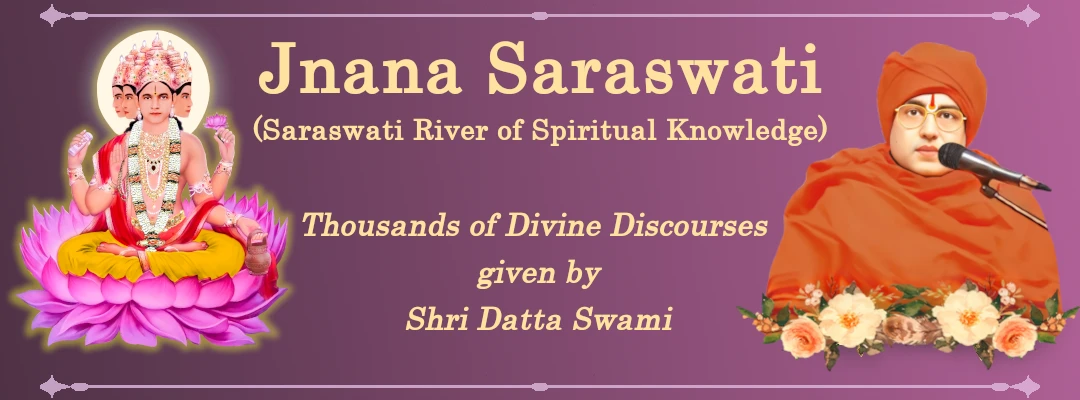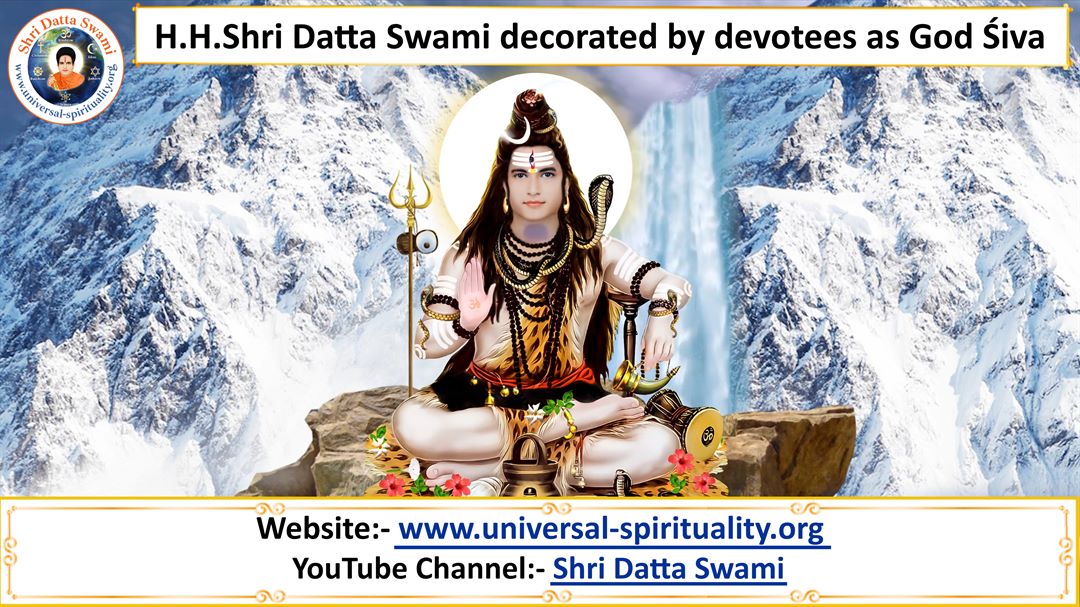
28 Sep 2024
O Learned and Devoted Servants of God
1. Please give a few guidelines to me to keep in mind for reading and understanding Divine Knowledge.
[Ms. Bhanu Samaikya asked: Padanamskaram Swami, Swami can you please tell the way and attitude to read spiritual knowledge. I'm with a very poor attitude and concentration. Please give a few guidelines for me to keep in mind for reading and understanding Divine Knowledge. -At Your Divine Lotus Feet, Bhanu Samykya.]
Swami replied:- Attitude and concentration are not important. The basic important point is your attraction towards something. That attraction will create attitude and concentration. Some people are attracted to God and become devotees due to removal of some difficulties or due to achievement of some benefits from God. Of course, such devotion is not pure devotion. But, in the beginning stage, impurities are inevitable like the smoke covering the fire in the initial kindled state. Slowly, the attraction becomes pure and the attraction towards His wonderful divine personality develops and in such pure state of devotion, the devotee is not bothered about anything to be achieved from God. Sometimes, such pure attraction comes to a soul from the previous birth and such a soul is born with pure attraction on God only like Prahlaada. Hence, you must try to develop such pure attraction towards God. You can read the spiritual knowledge, which projects the details of such beautiful personality of God. You can read the life histories of incarnations of God like the Bhagavatam etc. You are having a bright future in this spiritual line.

2. Shall we put equal effort on Jnaana Yoga, Bhakti Yoga and Karma Yoga?
[Shri Surya asked:- You told about three steps called jnaanayoga (spiritual knowledge), bhaktiyoga (devotion to God) and finally karmayoga (practical service and sacrifice). Shall we put equal effort on the three stages?]
Swami replied:- You can put a lot of stress on the 1st and 3rd stages. You can read and understand spiritual knowledge to any extent. Such knowledge generates inspiration and this inspiration is the force that is required to transform the knowledge into practice. You can do practical service and sacrifice also to any extent, which are beneficial only and not at all dangerous in any way. In this process, the middle step is emotional inspiration called Bhakti Yoga. Let such emotional inspiration to the required extent be generated from the study of spiritual knowledge so that the theoretical knowledge is transformed into practical devotion. When this purpose is served, you must control your spiritual emotion. Otherwise, your health will be spoiled due to excess of spiritual emotion since your heart and nervous system get damaged. You may ask that both knowledge and devotion are theoretical, in which case both should damage health equally. The answer for this doubt is that your intelligence deals with knowledge whereas your mind deals with devotion. Intelligence knows all the limitations, benefits and damages because intelligence is always bright to recognize every point in the logical analysis. Mind is simply blind and goes to any extent without recognizing the truth. If the second step, which is theoretical emotional devotion proceeds without self-control, madness results, which is counted by devotees as one path, which is the 9th stage (madness) followed by the 10th stage called death (Unmādo maraṇaṃ tataḥ). Gopikas became mad after God Krishna left them and they were staying in the forest of Brundavanam without attending to their household duties in their nearby village. God Krishna tried to rectify them by sending Uddhava, who taught Jnaana Yoga to the Gopikas. But, the stage was already out of hands and their madness was so powerful that Uddhava returned back with boundless emotional devotion! God Krishna aims at the control of this middle step called theoretical emotional devotion so that this generation of emotional devotion shall be controlled after a certain limit. The limit is that this emotion must be developed to transform the spirtual knowledge to practice. Beyond this required purpose, this middle step is unnecessary. The proof of the truth of this middle theoretical devotion is practical devotion. Once the practical devotion results, any more generation of theoretical devotion is unnecessary and must be controlled since it damages your health and hence, you cannot do the practical devotion or service to God also (apart from your worldly duties) effectively. Such devotees controlling the theoretical devotion after the generation of practical devotion is called Sthitaprajna and king Janaka was the best example as quoted in the Gita.
Theoretical devotion generated in controlled quantity is always essential not only to transform the knowledge into practice but also in doing the practical devotion. Suppose you are doing practical devotion (service and sacrifice) to Sadguru, who is the living incarnation of God, this theoretical devotion is also essential in that 3rd final step. Theoretical devotion brings obedience, submissiveness, fear, care etc towards Sadguru. During the practical devotion while pressing the feet of Sadguru or donating Guru Dakshina, you must show all these above-mentioned qualities of theoretical devotion (obedience, fear, care etc) as said in the Veda (Hriyā deyam, Bhiyā deyam). Hence, both theoretical devotion and practical devotion shall go together in equal proportions. You may be worshipping Sadguru theoretically, but, you may not be doing any practical devotion to Sadguru. In this case, theoretical devotion is full and practical devotion is nil. In another case, you may be doing full practical devotion but without any fear, obedience, care etc., and such case becomes the other side, which is full practical devotion and nil theoretical devotion. Both these cases become waste. You must do the practical devotion (service and sacrifice) to Sadguru along with the required theoretical devotion.
God stressed the practical devotion in the Veda and the Gita (Dhanena tyāgena… - Veda and Dhyānāt karmaphala tyāgaḥ... – Gita). Sadguru, the incarnation of God, will also stress on both theoretical and practical devotion. People shall not misunderstand Sadguru as greedy for service and sacrifice because God is not in need of anything from anybody since there is no unfulfilled desire in the case of God (Āpta kāmasya kā spṛhā?). The Gita also says that there is nothing, which is to be achieved or not already achieved by God (Nānavāpta mavāptavyam... - Gita). Suppose a student may be an excellent student in studies but is not paying the examination fees due to over greediness. The teacher preaches such student to pay the examination fees or sometimes, the teacher himself may pay the fees! Sadguru gives highest stress on the practical devotion only because this final step is very much stressed in the Veda and the Gita also. Hence, we shall not misunderstand that the Sadguru is preaching the spiritual knowledge with a view to grab money from devotees. If we misunderstand like that, we are the losers and not the Sadguru at all. Sometimes, God runs after the devotees, who run away from Him! This only shows the anxiety of the Sadguru to uplift those low type devotees. Sometimes, God runs away from the devotees, who are running after Him. This shows that those devotees are not in need of any help from God. We shall not misunderstand God in these two cases also.
The final conclusion is that the middle step called theoretical devotion (Bhakti Yoga) is certainly essential because the spiritual knowledge can be transformed into practice only through the theoretical devotion. Once the transformation into practical devotion is over, you can retain the theoretical devotion in fundamental state so that you can use it while doing the practical devotion. Under any circumstances, the emotional theoretical devotion must be controlled so that you can save your energy in doing the practical devotion and also in doing the propagation of spiritual knowledge of Sadguru. This concept is scientific and can be applied to health science. The energy supplied to a system must be used in doing actual work and shall be saved from unnecessary expenditure of rise of internal energy, which is emotion. This concept exists in the 1st law of thermodynamics (Q = △E + W). You shall not misunderstand that emotional devotion is not necessary. It is certainly necessary, but to the required extent only. Excess of emotional devotion will make the devotee mad and unfit to do any service or sacrifice to Sadguru or the contemporary human incarnation of God.
[Shri Srivatsa Datta asked:]
3. Scholars say that God is not achieved by money also and quote Veda as the authority in this context. How to correlate this?
Swami replied:- Actually, the Veda says that you cannot achieve God by rituals and by producing issues. The Veda mentioned the word ‘No’ (na) for these two items saying that just by doing rituals without devotion, there is no chance of getting God’s grace. Similarly, there is no use in producing issues because issues are not connected to the spiritual field. Shankara, Ramakrishna Paramahamsa etc., did not have issues. The 3rd item mentioned in the Veda is sacrifice of money and before this item, the word ‘no’ (na) is not mentioned. The whole version of the Vedic statement is ‘Na karmaṇā na prajayā dhanena tyāgena eke amṛtattva mānaśuḥ’. Here, you can see the word ‘na’ (no) before ‘karmaṇā’ (rituals) and ‘prajayā’ (issues) only and not before ‘Dhanena tyāgena’. The sacrifice of wealth is the most difficult step because this alone can give the true proof for the true love on God. This concept is already very much valid in worldly life (Pravrutti) also and you need not think that this concept is newly brought into Nivrutti only. God Krishna sharpened this Vedic concept into a further accurate concept. He replaced wealth by hard-earned money. Dhanam (wealth) is replaced by fruit of work (Karma Phalam) in the Gita. The reason is that one will have a stronger bond with his/her hard-earned wealth than the wealth given by ancestors. God competes with this strongest bond in the test so that if you vote for God against the hard-earned money, God becomes stronger than your strongest bond, which means that bond with God is the real strongest bond. These scholars insert the word ‘na’ (no) before the word ‘dhanena’ also even though in the original text of the Veda, this word ‘na’ (no) is clearly absent. Then, why scholars are inserting this word ‘no’ (na) before wealth also? The scholar fears that if the true meaning of the truly existing Vedic statement is explained, people will get tension because the sacrifice of money is stressed and due to this tension, people may leave and go without hearing the further speech of the scholar! When the scholar says that God is not achieved by money also, people will sit with a lot of happiness. Now, the scholar sends the Aarti plate for taking donations from the same people. Since the people are already in a very much pleased state, they donate whatever they please. This is the politics in this affair. A true Sadguru will not fear for such action of the public and is not in need of anything from anybody. Hence, He will explain the Vedic authority as it is since He is not aspiring anything from anybody.
★ ★ ★ ★ ★